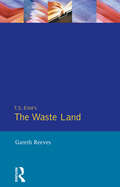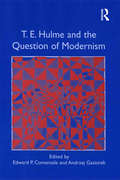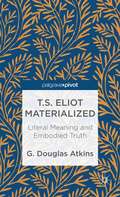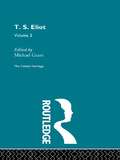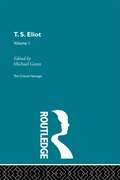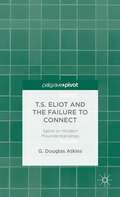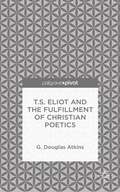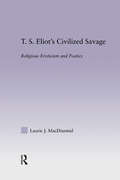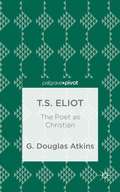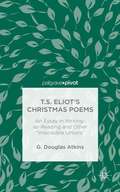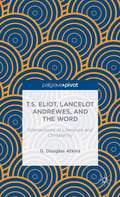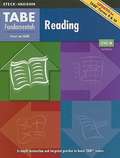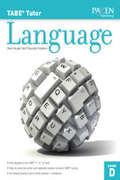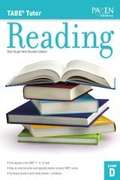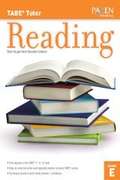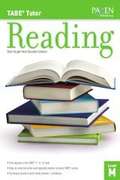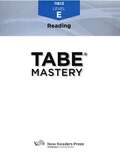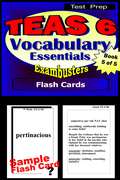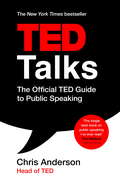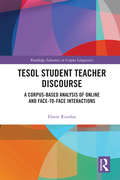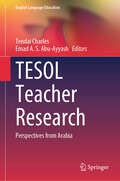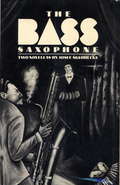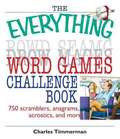- Table View
- List View
T. S. Elliot's The Waste Land
by Gareth ReevesThis work argues that although "The Waste Land" demands close reading, the spirit of the old New Criticism works with inappropriate assumptions about unity and closed form. Many critics have tried to fix the text, to find hidden narratives and plots, spiritual guests and allegories of salvation. Instead, this reading sees the poem as resolutely open-ended, supporting this view with recent developments in Reader-Response criticism and Reception Theory. The study focuses on the way poetry sounds (or does not sound, cannot be sounded). It concentrates on syntax, lineation and intonation. It also brings out the presence of the muted voices of wronged women in a work often called misogynistic.
T.E. Hulme and the Question of Modernism
by Andrzej GasiorekThough only 34 years old at the time of his death in 1917, T.E. Hulme had already taken his place at the center of pre-war London's advanced intellectual circles. His work as poet, critic, philosopher, aesthetician, and political theorist helped define several major aesthetic and political movements, including imagism and Vorticism. Despite his influence, however, the man T.S. Eliot described as 'classical, reactionary, and revolutionary' has until very recently been neglected by scholars, and T.E. Hulme and the Question of Modernism is the first essay collection to offer an in-depth exploration of Hulme's thought. While each essay highlights a different aspect of Hulme's work on the overlapping discourses of aesthetics, politics, and philosophy, taken together they demonstrate a shared belief in Hulme's decisive importance to the emergence of modernism and to the many categories that still govern our thinking about it. In addition to the editors, contributors include Todd Avery, Rebecca Beasley, C.D. Blanton, Helen Carr, Paul Edwards, Lee Garver, Jesse Matz, Alan Munton, and Andrew Thacker.
T.S. Eliot Materialized
by G. Douglas AtkinsBy reading T. S. Eliot literally and laterally, and attending to his intra-textuality, G. Douglas Atkins challenges the familiar notion of Eliot as bent on escaping this world for the spiritual. This study culminates in the necessary, but seemingly impossible, union of reading and writing, literature and commentary.
T.S. Eliot Volume 2: The Critical Heritage (The\critical Heritage Ser.)
by Michael GrantThis set comprises 40 volumes covering nineteenth and twentieth century European and American authors. These volumes will be available as a complete set, mini boxed sets (by theme) or as individual volumes. This second set compliments the first 68 volume set of Critical Heritage published by Routledge in October 1995.
T.S. Eliot Volume I
by Michael GrantThis set comprises 40 volumes covering nineteenth and twentieth century European and American authors. These volumes will be available as a complete set, mini boxed sets (by theme) or as individual volumes. This second set compliments the first 68 volume set of Critical Heritage published by Routledge in October 1995.
T.S. Eliot and the Failure to Connect: Satire and Modern Misunderstandings
by G. Douglas AtkinsHere, G. Douglas Atkins offers a fresh new reading of the past century's most famous poem in English, T. S. Eliot's The Waste Land (1922). Using a comparatist approach that is both intra-textual and inter-textual, this book is a bold analysis of satire of modern forms of misunderstanding.
T.S. Eliot and the Fulfillment of Christian Poetics
by G. Douglas AtkinsApplying new readings of Four Quartets, this book completes a trilogy on the Christian character of Eliot's writing.
T.S. Eliot's Civilized Savage: Religious Eroticism and Poetics
by Laurie MacDiarmidT. S. Eliot's Civilized Savage revisits this poet's drafts and canonical poetry in a sometimes dismissive critical arena . While contemporary readers emphasize Eliot's charged personal life, his anti-Semitism, his political conservatism, and his misogyny, Laurie MacDiarmid argues that although Eliot's poetics are shaped by private fears and fantasies, in many ways these are the ghosts of a culture that accepts and celebrates him. Comparing early versions with finished poems, this book explores the development and ramifications of Eliot's 'impersonal' poetic without losing sight of his influential, haunting work. Examining Eliot's neurotic relationship with women and his escape into women and his escape into spirituality, this book observes how Eliot conceived and eroticized poetry of worship and a poetic that dictated a sacrificial relationship to a savage God.
T.S. Eliot: The Poet as Christian
by G. Douglas AtkinsBy comparing and contrasting the pre-conversion and the post-conversion poetics and poetic practices of T. S. Eliot, this book elucidates the responsibilities and opportunities for a poet who is also Christian. This book is the second in a trilogy which includes T. S. Eliot, Lancelot Andrewes, and the Word.
T.S. Eliot’s Christmas Poems: An Essay in Writing-as-Reading and Other "Impossible Unions"
by G. Douglas AtkinsThis is the first full-scale analysis of T. S. Eliot's six "Ariel Poems" as Christmas poems. Through close readings, Atkins argues that these poems considered together emerge as clearly related representations of the "impossible union" that occurred in the Incarnation.
T.s. Eliot, Lancelot Andrewes, And The Word: Intersections Of Literature And Christianity
by G. Douglas AtkinsWith special attention to the poems For Lancelot Andrewes, Journey of the Magi, and Ash-Wednesday , G. Douglas Atkins offers an exciting new analysis of T. S. Eliot's debt to the seventeenth-century churchman Lancelot Andrewes and his theories of reading and writing texts.
TABE Fundamentals: Reading, Level M (2nd edition)
by Steck-VaughnTABE stands for the Tests of Adult Basic Education. These paper-and-pencil tests, published by McGraw-Hill, measure your progress on basic skills. There are five tests in all: Reading, Mathematics Computation, Applied Mathematics, Language, and Spelling.
TABE Tutor Reading Level D
by Paxen PublishingTABE® stands for the Tests of Adult Basic Education. These tests are published by Data Recognition Corporation. TABE® 11 & 12 aligns with College and Career Readiness Standards and measures progress on the basic skills that adults need to succeed on the job and in life.
TABE Tutor Reading Level E
by Paxen PublishingTABE® stands for the Tests of Adult Basic Education. These tests are published by Data Recognition Corporation. TABE® 11 & 12 aligns with College and Career Readiness Standards and measures progress on the basic skills that adults need to succeed on the job and in life.
TABE Tutor Reading Level M
by Paxen PublishingTABE® stands for the Tests of Adult Basic Education. These tests are published by Data Recognition Corporation. TABE® 11 & 12 aligns with College and Career Readiness Standards and measures progress on the basic skills that adults need to succeed on the job and in life.
TEAS 6 Test Prep Flash Cards: Vocabulary Essentials (Exambusters TEAS 6 Workbook #5 of 5)
by Ace Inc.<P><P><i>Advisory: Bookshare has learned that this book offers only partial accessibility. We have kept it in the collection because it is useful for some of our members. Benetech is actively working on projects to improve accessibility issues such as these.</i><P><P> 350 frequently tested words every college graduate should know. Perfect for anyone who wants to enrich their vocabulary! Improve your reading comprehension and conversation. Includes sample sentence, part of speech, pronunciation, succinct, easy-to-remember definition, and common synonyms and antonyms. <P><P>Exambusters TEAS 6 Prep Workbooks provide comprehensive, fundamental TEAS V review--one fact at a time--to prepare students to take practice TEAS V tests. Each TEAS V study guide focuses on one specific subject area covered on the TEAS V exams. From 300 to 600 questions and answers, each volume in the TEAS V series is a quick and easy, focused read. Reviewing TEAS V flash cards is the first step toward more confident TEAS V preparation and ultimately, higher TEAS V exam scores!
TED Talks: The official TED guide to public speaking: Tips and tricks for giving unforgettable speeches and presentations
by Chris Anderson'This is not just the most insightful book ever written on public speaking-it's also a brilliant, profound look at how to communicate' - Adam Grant, author of ORIGINALSIn Ted Talks Chris Anderson, Head of TED, reveals the inside secrets of how to give a first-class presentation. Where books like Talk Like TED and TED Talks Storytelling whetted the appetite, here is the official TED guide to public speaking from the man who put TED talks on the world's stage. 'Nobody in the world better understands the art and science of public speaking than Chris Anderson. He is absolutely the best person to have written this book' Elizabeth Gilbert.Anderson shares his five key techniques to presentation success: Connection, Narration, Explanation, Persuasion and Revelation (plus the three to avoid). He also answers the most frequently asked questions about giving a talk, from 'What should I wear?' to 'How do I handle my nerves?'.Ted Talks is also full of presentation tips from such TED notable speakers as Sir Ken Robinson, Bill Gates, Mary Roach, Amy Cuddy, Elizabeth Gilbert, Dan Gilbert, Amanda Palmer, Matt Ridley and many more. This is a lively, fun read with great practical application from the man who knows what goes into a truly memorable speech. In Ted Talks Anderson pulls back the TED curtain for anyone who wants to learn how to prepare an exceptional presentation.
TESOL Career Path Development: Creating Professional Success
by Liz EnglandThis book addresses a wide range of issues and obstacles that teachers in native and non-native English-speaking countries face in teaching English language learners of all ages, at all levels of proficiency, and in a variety of program settings. The book introduces a model of milestones for career path development specific to the specialized needs and skills of the TESOL (Teaching English to Speakers of Other Languages) community that caters to the many unique challenges faced by teachers at a range of experience levels, from preservice and novice teachers to veteran and semi-retired professionals. Taking an interdisciplinary approach and drawing on the voices and experiences of TESOL scholars, England demonstrates how best to apply one’s education, background, and experiences to individuals who work in the field of TESOL, and offers unique tools, strategies, and training techniques. This book provides a clear and engaging framework for scholars and teachers at any stage in one’s career to grow and develop professionally in fast-changing and increasingly complex professional climates. This book is ideal for scholars, graduate students, and researchers in TESOL and language teaching, as well as scholars and researchers in international teacher development and language.
TESOL Student Teacher Discourse: A Corpus-Based Analysis of Online and Face-to-Face Interactions (Routledge Advances in Corpus Linguistics)
by Elaine RiordanThis book explores the use of online and face-to-face interactions in language teacher education (LTE) by assessing the formation and practices of a community of practice (CoP), and evaluating the roles discussions between student teachers and a peer tutor can play in terms of identity formation, articulating narratives, reflective practices, and maintaining affective relationships. The specific context within which this is embedded is a Teaching English to Speakers of Other Languages (TESOL) programme, often known as English Language Teaching (ELT), at a third-level Irish institution. The data drawn on come from student teachers on a master’s (MA) programme who interacted with a peer tutor (the researcher) via a number of modes (face-to-face and online). The approach to data analysis is a corpus-based discourse analytical one, which examines the linguistic features of student teacher and peer tutor talk; the features of CoP practices in the discourse; and how different modes of communication shape the nature of this discourse. Perceptive data from the student teachers is used to outline their reactions to the modes of communication and the activities they participated in.
TESOL Teacher Research: Perspectives from Arabia (English Language Education #35)
by Tendai Charles Emad A. S. Abu-AyyashThis edited volume provides a comprehensive and detailed insight into the Teaching of English as a Second Language (TESOL) in the United Arab Emirates (UAE). It describes a variety of challenges that native speakers of Arabic face when learning the English language and presents contemporary teaching strategies for supporting them. The book provides analyses of TESOL syllabi and policies currently adopted in the UAE’s K-12 education sector, addressing strengths and areas which can be improved. The book also includes a critical discussion about the difficulties of implementing Western-based TESOL methodologies in a Middle Eastern context, from the perspectives of real-world practitioners. By presenting a combination of research-based and theory-based chapters, this book is a great resource to TESOL-related graduate students, teachers-in-training, educational leaders and policy makers in the UAE and beyond.
THE BASS SAXOPHONE
by Josef SkvoreckyFirst published in 1980, The Bass Saxophone was chosen as Book of the Year by The Guardian. This internationally acclaimed classic of jazz literature is now available in a handsome new edition with a new contribution by the author. As an introduction to these two novellas, Skvorecky writes a remarkable personal memoir of his jazz-obsessed youth under two dictatorships. (2001)
THE EVERYTHING® Word Games Challenge BOOK
by Charles TimmermanChapter themes include: - What's in a Name?- Word Ladders- Inside Words- Logogriphs
THE NEW Writing with a Purpose,Fourteenth Edition
by Joseph F. TrimmerThe book provides comprehensive coverage of the materials and problems basic to the introductory writing course and provides emphasis on the role of purpose in the writing process.
